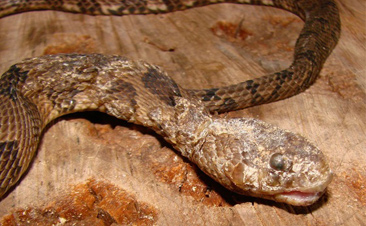(Other names: ophidiomycosis)

Description
Snake fungal disease (SFD) is an emerging disease that infects snakes. SFD is thought to be caused by the fungal species Ophidiomyces ophidiicola. Due to the novelty of this disease, there are still many unknown factors related to transmission, infection, and population effects. Diagnosis can be difficult because other pathogens may cause similar signs of disease in snakes.
The first confirmed case of SFD in the United States occurred in Illinois in 2008. SFD was first identified in Indiana during a state-wide surveillance effort in 2017. Based on these surveys conducted from 2017 – 2019, the causative agent of SFD was identified in 23 Indiana counties and 12 species of snakes, which included two state endangered species (Timber rattlesnakes and Kirtland’s snakes).
Transmission
Mechanisms of transmission are still uncertain. Snakes are likely to become infected with SFD through contact with other snakes or through direct contact with the fungus in the environment. The fungus can persist in soils at a wide range of temperatures but is more prevalent where snakes hibernate than in topsoil. For this reason, SFD is commonly observed on snakes that are emerging from hibernation. Transmission may also occur from mother to offspring.
After exposure to the fungus, many snakes will develop scale discolorations at the infection site. Once the fungus penetrates the exterior layer of scales, it causes lesions and other clinical signs.
Clinical Signs
Clinical signs of SFD are nonspecific but can include mild dermatitis, premature shedding, subcutaneous nodules (i.e., lumps under the skin), and/or corneal opacities. The most common signs are facial swelling and/or lesions, which can impair feeding abilities. Severe infection can lead to death; however, SFD is not currently known to have a high overall fatality rate. Although many snakes do not show signs of infection, some snake species, such as the endangered Eastern massasauga, are particularly susceptible and may have mortality rates as high as 90%.
Wildlife Management Implications
Most snakes are likely susceptible to SFD. Indiana is home to nine state endangered snakes and four snakes of special conservation concern. The population effects of SFD are currently unknown, but this disease can likely cause negative effects on species that are already vulnerable. Early and rapid detections of SFD in Indiana are important for monitoring the spread of this potentially fatal disease. You can help track SFD by submitting a Sick or Dead Wild Animal Report to Indiana DNR if you encounter a snake exhibiting signs of SFD.
Human Health Significance
SFD is not known to affect human health.
Additional Resources
- USGS National Wildlife Health Center
- Cornell Wildlife Health Lab
- Campbell, L. J., Burger, J., Zappalorti, R. T., Bunnell, J. F., Winzeler, M. E., Taylor, D. R., & Lorch, J. M. (2021). Soil Reservoir Dynamics of Ophidiomyces ophidiicola, the Causative Agent of Snake Fungal Disease. Journal of Fungi, 7(6), 461.
- Davy, C. M., Shirose, L., Campbell, D., Dillon, R., McKenzie, C., Nemeth, N., ... & Jardine, C. (2021). Revisiting ophidiomycosis (snake fungal disease) after a decade of targeted research. Frontiers in veterinary science, 8, 448.
- Jiménez, E. A. (2021). Estimation of Prevalence and qPCR Copy-Number of Ophidiomyces ophiodiicola and Snake Fungal Disease in a Snake Community in Southern Illinois, with Notes. Herpetological Review, 52(1), 45-48.
